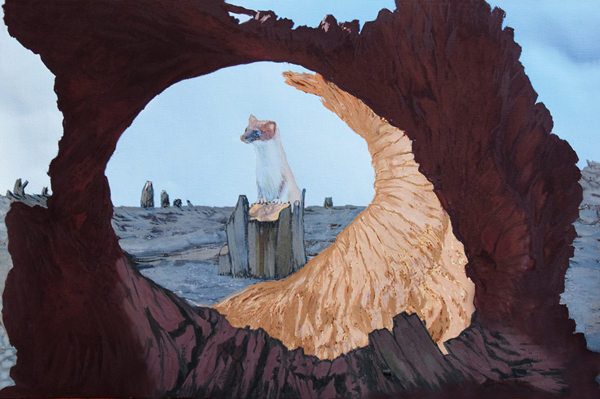
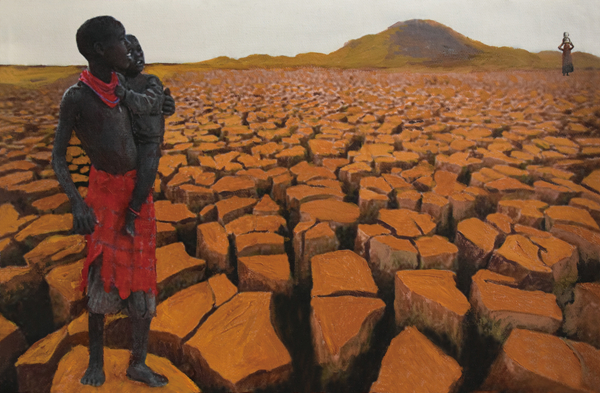
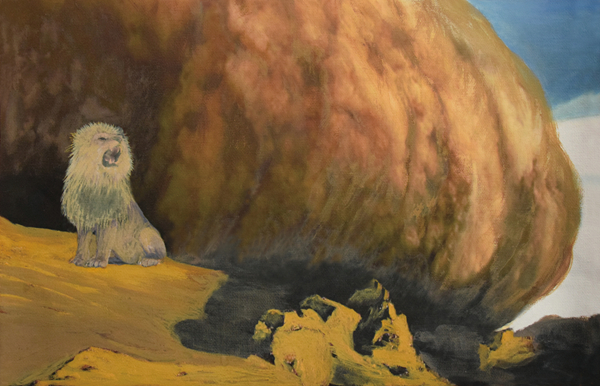
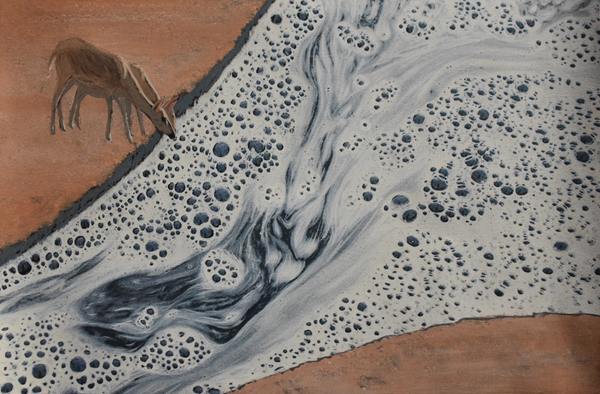
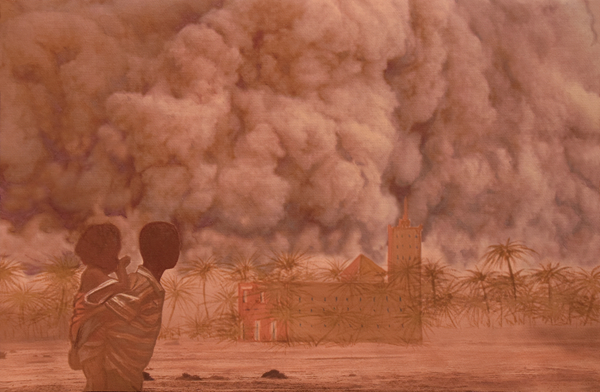
Zhang Anhua, vice chairman of Arts Association under China Electricity Council and director of the think-tank of Ecological Civilization Research of Chinese Academy of Social Sciences has created a series of oil paintings theming ecology and environmental protection in recent years - Drought Series, Dust Storm Series, Forest Destruction Series, Water Pollution Series , recording changes in the Earth's ecological environment and climate in recent years, showcasing the inner sensation in the language of art under direct expression, or reflection and refraction via a unique perspective.
Calling for a beautiful homeland with oil painting
Perhaps due to his studying and working experience, Zhang Anhua began to pay attention to the issue of environmental protection when he entered the Graduate School of the Chinese Academy of Social Sciences in 2002 to study the economics of sustainable development, as the problems of smog and water pollution have not attracted no much attention at that time. Zhang Anhua said: "In fact, from that time on, I hope that I can do something within my power to protect the environment and be an environmental volunteer. For environmental protection issues, if it is just oral presentation and written promotion, in some ways, the effect is so limited. But the expression in the form of painting can vividly express the problem of the ecological environment, an easy accessiblilty, and it is also easy to make people resonate with the soul."
Some people believe that using photography to express ecological and environmental problems will be more objective and genuine. In fact, in addition to painting, photography, calligraphy, literature and other different forms of art were all used by Zhang Anhua, but he produced his own answer through a long time contrasting creation and thinking: "Photography is a fact-based record, and painting can be more effective in expression of ideas, which is through the subjective creation to reproduce the true nature of the art to make the work more expressive and appealing. Compared with Chinese paintings and prints, oil paintings are more suitable for realistic creations of realism, which could better express the theme of environmental protection through detailed depiction, three-dimensional display, and the use of special oil painting language. "
Through oil painting, Zhang Anhua expressed his thoughts: "With the advancement of science and technology and the social productive forces, the mankind has created unprecedented material wealth, and the economy and society have continued to develop, but at the same time, various environmental problems have become increasingly prominent, requiring all human beings to jointly put into action and proactively respond. I hope that through painting, more people will pay attention to environmental protection issues and participate in pertinent actions via such an easy-to-understand way, so that the earth can be restored to health and the homeland will be more beautiful."
Respect for life is the eternal power
The renowned French sculptor Auguste Rodin once said: "Art is emotion." Indeed, painting is the sound from the heart, love is the emotional source for the painting. Painting is an art of emotional expression, relying on the creator's perception of life and the expression of artistic skills to convey emotions. Zhang Anhua's series of works incorporates his deep concern about the ecological environment. He employs realistic expression techniques to depict the natural destruction. Through art, he calls people to show fear to nature and protect it, appealing for harmony between mankind and the nature.
In art works, the deeper emotional expression is in regard to the thinking and care of humanity. He said: "As a classic art form, oil painting can convey people's deep thoughts and emotions, showing the mysteries of inner life and expressing enthusiasm for the natural world. We should give due enthusiasm to the contemporary society so as to enable the artistic works to contain a profound humanistic spirit. Only by deeply caring about social issues and having a high humanistic spirit can the works truly produce artistic power that touches people's hearts."
Adhering to this creative concept, Zhang Anhua's oil paintings present a strong sense of humanity and respect for nature and life. In his Environmental Destruction Seriesworks, the lonely and helpless golden monkey mother and child, the cars and people drowned by sandstorms... deeply touching the hearts of the people, reflecting his love for nature, respect for life, and the sorrow of ecological environment destruction, the eternal power of his persistent creation.
Drawing nutrition from traditional painting and thought
The idea of "the union of heaven and human" in Chinese traditional philosophy is the basic cosmology of ancient China, containing the inseparable unity of man and nature, the value of life, the love of the universe, and the harmonious development of man and nature. This thought has created great impact on Zhang Anhua. "According to the traditional Chinese philosophy of 'the union of heaven and human', people and nature must coexist harmoniously and interactively, instead of conquering and plundering nature. Therefore, to solve the ecological environment problem, it is necessary to solve the human's consciousness in this regard. The relationship between man and nature should be harmonious and symbiotic. For the grass and trees in the great nature, people should be grateful and caring for them," Zhang Anhua said. On this basis, he observes art from the perspective of nature and ecology, presenting the relationship between oil painting and human spiritual state, and that between ail painting and cultural ecology from the perspective of ecology, showing a kind of novel ecological painting. He uses brushes to create a natural environment, and the color to convey his inner feelings, creating the ecological paintings, such as Harmony and Splendid, which attracted wide attention and praise.
He believes that excellent works of art should be works of affection (emotional) and significance (meaning), and works with morality, humanity and reality can truly touch the hearts of the people with their practical significance. He says: "In the moment, the problem of poverty may be partial, while the environmental problem is global. Global warming, melting of the Antarctic and Arctic, deforestation, air pollution, water pollution... The issue of ecological environment is one of the most concerned issues of the domestic and international community. Strengthening environmental protection publicity is of most important practical significance. Therefore, I am eager to inspire the viewers to recognize and reflect on the phenomenon of ecological destruction in the form of art, and to reflect on and correct some of the human actions, striving to leave green hills, blue sky and clear water for future generations."














